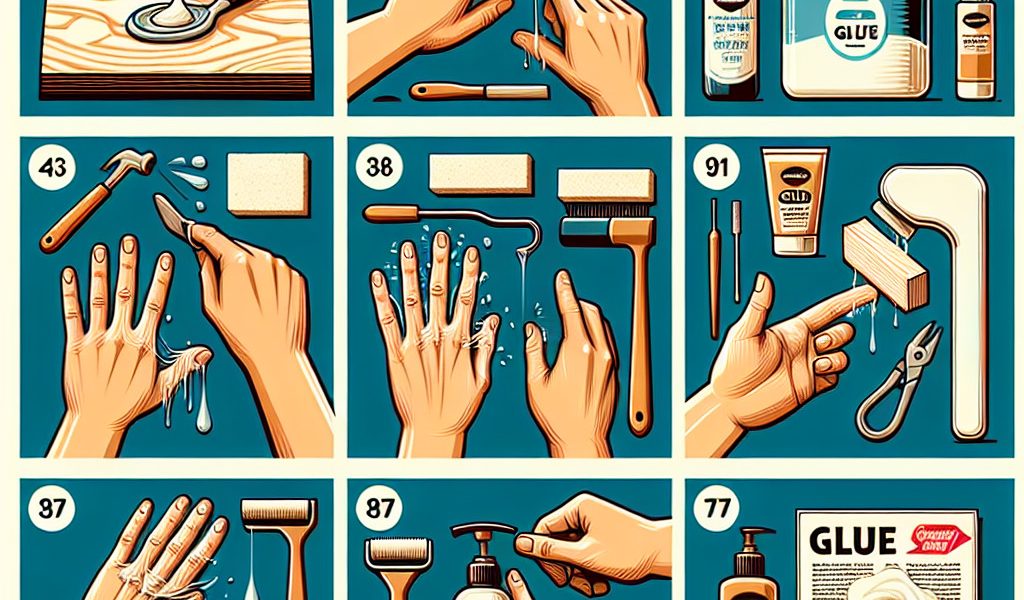Sticky Situation: Easy Solutions on Safely Removing Glue from Fingers and Various Surfaces
Introduction
Super glue, also known as cyanoacrylate, is a very powerful glue that adheres quickly to various surfaces. It can be useful for repairing broken objects or gluing materials together. However, it can also cause problems when it comes into contact with skin or other surfaces where it is not wanted. In this article we will show you how to remove glue from fingers and other surfaces such as wood, metal, plastic and fabrics.
Removing glue from fingers
When you accidentally get super glue on your fingers, it’s important to act quickly to prevent the glue from drying out completely. Here are some effective methods:
- Hot soapy water: Dip your fingers in a bowl of warm water mixed with liquid soap for about 15 minutes. Gently rub your fingers together to gradually loosen the glue.
- Acetone: Acetone (the main component of nail polish remover) is an effective solvent for dissolving super glue. Apply a small amount of acetone to a cotton swab and rub it over the affected area until the glue dissolves. Be careful, acetone can irritate the skin and should not be used on sensitive areas such as the eyes or lips.
- Scouring cream: Apply a small amount of scouring cream (such as Cif) to your fingers and rub them together to gradually remove the glue. Then rinse your hands with lukewarm water.
Removing glue from wood
To remove dried super glue from wood, follow these steps:
- Gently scrape off excess glue with a flat, stiff object, such as a plastic spatula or credit card. Avoid using metal objects that could scratch the wood.
- Apply a suitable solvent to dissolve the remaining glue. Acetone works well in this case too, but it is recommended to carry out a test in an inconspicuous place beforehand to verify that it does not affect the finish of the wood.
- Rub gently with a damp cloth dampened with a mixture of warm water and liquid soap to remove any residue.
Important note:
Never use sandpaper or an electric sander directly on the wood to remove super glue, as this may damage the surface and cause scratches.
Removing glue from metal
Metal is generally less sensitive to solvents than other materials. To remove super glue from metal, follow these steps:
- Gently scrape off excess glue with a flat, stiff object, such as a plastic spatula or credit card.
- Apply a solvent such as acetone or nitromethane (another solvent commonly used to dissolve adhesives) to a clean cloth and gently rub it over the affected area until the glue dissolves.
- Rinse with lukewarm water and dry thoroughly with a clean cloth.
Removing glue from plastic
Some super glue removal methods can damage plastic. Here’s how to do it without causing damage:
- Freezer method: Place the plastic item in the freezer for about two hours. The low temperature will make the glue more brittle, making it easier to remove using a flat, stiff object (as mentioned previously).
- Non-aggressive solvent: Use a solvent specifically designed for plastics, such as De-Solv-It Sticky Stuff Remover. Apply it to a clean cloth and gently rub the affected area until the glue dissolves.
Removing glue from fabrics
Super glue stains on clothing can be difficult to remove. Here are a few tips :
- Let the glue dry completely (do not try to remove it while it is still wet).
- Gently scrape off excess glue with a flat, stiff object.
- Apply a small amount of acetone or other suitable solvent to dissolve any remaining glue. Be sure to test the solvent on an inconspicuous part of the garment beforehand to verify that it does not affect its color or texture.
- Then wash the garment according to the care instructions provided by the manufacturer.
Safety Tips When Using Chemicals
When using chemicals like acetone or other solvents, always make sure:
- Work in a well-ventilated area to avoid prolonged inhalation of vapors.
- Use rubber gloves to protect your skin from potential irritation caused by these products.
- Store chemicals out of reach of children and pets.
Conclusion
By following these tips, you should be able to effectively remove super glue from your fingers and various surfaces without causing damage. Remember that prevention is always best: work carefully with super glue to avoid accidents and always keep a suitable solvent on hand just in case.
